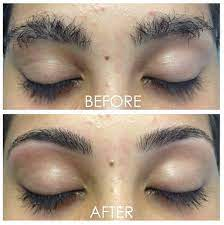INTRODUCTION
Traditionally, the remedy for thin or sparse eyebrows has been to rely on makeup products to “fill in” eyebrow hairs. However, there’s an increased interest in a more permanent solution: the eyebrow transplant.
An eyebrow transplant is performed by a cosmetic or plastic surgeon with the transfer of your own hairs.
While the procedure seems straight forward, there are multiple aspects to consider, from cost to risks and side effects. Keep reading to learn what to expect from an eyebrow transplant and how to determine whether this surgery is right for you.

What is an eyebrow transplant?
An eyebrow transplant is a cosmetic procedure where hair grafts (plugs) are transferred to your brow area. This goal is that new hairs will grow from these grafts, producing a fuller look.
Procedure
The actual procedure is similar to a traditional hair transplant.
Eyebrow hair grafts are taken from hairs above your ears. A surgeon transfers not just the individual hairs, but the hair follicles, too. This helps to ensure that new hairs are able to grow in your eyebrows once the initial transferred ones fall out.
After you’re given a general anesthetic, a surgeon will make small incisions at the follicle donor sites, as well as at the sites of transplantation in your brows. The entire process takes about 2 to 3 hours.
Pros and cons
Proponents of eyebrow hair transplants note that the new hairs look natural because they’re your own. The procedure may also limit the need for brow makeup.
However, there are also reported downsides to this procedure. For one, it’s costly. It can also take several months until the new follicles “take” so that you see full results. Finally, there’s a chance that these new follicles won’t produce new hairs.
What’s the recovery like for an eyebrow transplant?
The recovery period for an eyebrow transplant is relatively quick. You’ll notice some scabbing around the brows within the first few days. It’s important to not pick at these.
You may need to avoid vigorous exercise for up to 3 weeks following your surgery. Call your surgeon if you experience any bleeding, swelling, or pus at the site.
You’ll start to see the transplanted hairs fall out after a few weeks. This is completely normal. Your new brow hairs should start to grow over the next several months. In the meantime, you may need to trim the transplanted hairs to brow length.
Precautions and side effects
One potential risk of an eyebrow transplant is that the new hair follicles won’t take. In such cases, you may have to have the procedure done again in the future.
There are also risks associated with the surgery itself. Talk to your surgeon about the following potential complications:
- excessive bleeding
- nerve damage
- swelling
- bruising
- infection
- scarring
Before your eyebrow transplant, your surgeon will go over your medical history with you. Be sure to disclose any underlying health conditions, as well as any medications or supplements you currently take.
An eyebrow transplant may not be suitable if you have:
- alopecia areata
- trichotillomania
- bleeding disorders
- a history of complications related to cosmetic surgery
How much does it cost?
An eyebrow transplant is considered a “nonmedical” procedure. This means it’s not typically covered by health insurance. Eyebrow transplants are similar to other cosmetic procedures, including injectables.
One exception to the health insurance rule is if your eyebrow transplant is deemed necessary due to hair loss from an accident or an underlying medical condition. Such cases are less common, though. You would still be responsible for any copays and deductibles required by your insurance plan.
It’s also important to be aware of potential costs outside of the initial procedure. For example, if you desire additional implants after the recovery phase, you will need to pay for these per your provider’s costs.
Many providers have payment options to help their patients offset the costs of their cosmetic procedures. This may come in the form of special discounts, financing, or payment plans. Ask your provider about these options before booking your eyebrow transplant
Where should you have this procedure done?
Eyebrow transplants are performed by dermatologic, cosmetic, or plastic surgeons. A doctor may do the surgery in an outpatient facility or a medical spa.
It’s a good idea to shop around for the right provider before committing to the procedure. Ask the surgeon about their credentials and experience. Ideally, they should also have a portfolio of work to show you so that you can gain a sense of their skills
Key takeaways
An eyebrow transplant may offer long-term results if you’re not happy with the look of your eyebrows and want a more permanent solution. However, results can vary, and there’s always a risk of side effects with cosmetic surgery. This is true even with a procedure as seemingly simple as an eyebrow transplant.
Weigh all your options carefully and ask your doctor for advice. If you do decide to go forward with an eyebrow transplant, take time to research and find a reputable provider who will do the best possible job.
FAQ
Q1 How long do eyebrow implants last?
A1 Once transplanted, the follicles will grow new hairs beginning 3-4 months after the procedure and best results are seen at 6-8 months. Actress Meagan Good recently underwent a successful eyebrow transplant with Dr. Ashwani Kumar
Q2 How much is an eyebrow transplant In India?
A2 The eyebrow transplant cost depends upon the number of grafts he or she might need for transplanting on the eyebrow-less areas. The clinic you approach will discuss the cost of eyebrow transplantation after examining your eyebrow hair conditions. They may charge per grafts from INR 15 to INR 25.
Q3 How many grafts are needed for eyebrow transplant?
A3 A standard eyebrow transplant procedure typically requires 50 to 100 hair grafts, but it could be more depending on the patient’s condition.
